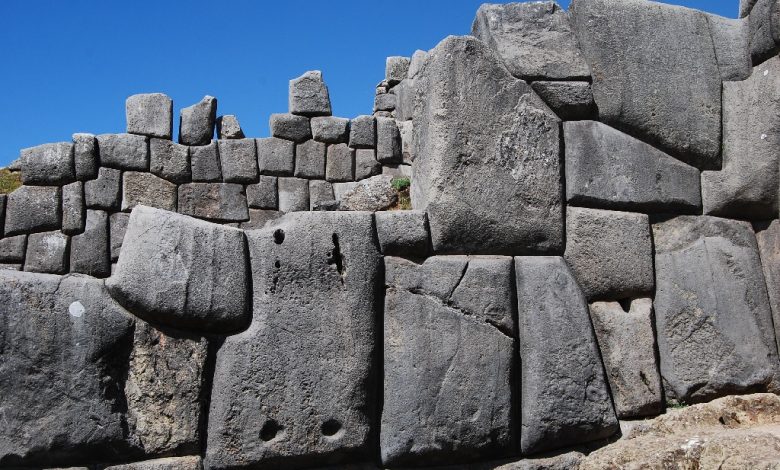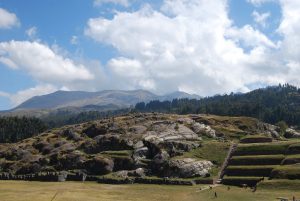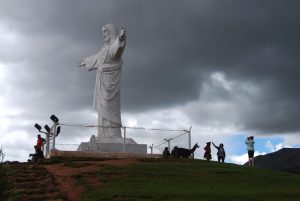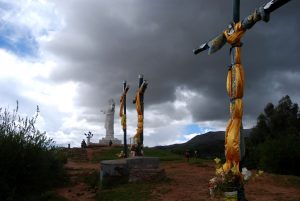Sacsayhuaman, the Great God of Cuzco

Sacsayhuaman reclines on the crest above Cuzco. A very important site for Inca Cuzco, massive in grandeur, it continues to be important today for tourism and as a place of assembly in grand moments, such as during the Inti Raymi re-creation. But it is even more.
Anthropologist Abraham Valencia Espinoza, from Cuzco’s University of San Antonio Abad, in his study of the contemporary religious life of the city notes that for many people Sacsayhuaman is the Apu, the maximal deity of Cuzco.
Tourists walk around its massive zigzagging face, opening on the esplanade, and walk through its passageways to its top, overlooking the city. While there they marvel at the amazing stonework, seeming without equal, feeling the issue is firmly in a past that is well behind us in this world built on a linear time of year proceeding ever onward in numerical splendor.

But for the ancient Peruvians and many modern people, according to the implications of Valencia’s work, that numerical model of a past gone such that 1490 will always be before and separated from 2013 did not hold. Instead the model was of daily movement from the earth outward, like the sun rising, and back into the earth at night.
While tourists see the impressive stones, taller than they are, as a finished work in ruin, isolated in its individuality, Andeans will see it in relationship with the land below it, above it, and to its sides, and all of that under the sky.

As a result, Saqsayhuaman does not lie inert, a remnant of a past when Incas ruled, it is part of a holy precinct of many shrines beneath it, around it, and above it in which the past is still alive within.

Valencia narrates how as Apu Sacsayhuaman continues to have a hold on the devotional lives of many contemporary Cusqueños whether in the city or in rural communities. This Apu is considered to watch over, to protect, the people while at the same time controlling them, in the sense of taking note of and responding to.
Many communities nearby use the image of a shepherd watching his flocks to understand this. They see people as the domestic animals, the flocks of the Apus.

As a result, the Andean priests, the altomisayoq, of the areas near Cuzco will offer coca to Sacsayhuaman and will seek his permission for activities. They say that the Apu has a spirit and that it communicates with people. The people petition him throughout the day and at night must take account of their dreams which is one place where the Apu communicates with them. The dreams will indicate the Apu’s will.
People continue to make offerings to Sacsayhuaman and to take him very seriously in their lives. But he is not alone, he forms part of a large area of sacred sites and caves, many of them marked with crosses. The presence of the cross is not only a signal of the Catholic Church’s attempts to impose Christianity on top of Andean belief and practice, but it is something living in the lives of people as they engage with the land and its spirits and energy.

The crosses generally form the center of brotherhoods organized to carry out an annual round of ritual in their behalf, including annual feasting. They are especially celebrated in the Feast of the Cross, the Cruzvelakuy, of the second and third of May. As a result, they indicate the continuing engagement of the people of Cuzco with these holy places in their landscape.
Valencia relates how interactive these crosses can be. He tells of the Cross of Sacsayhuaman itself and how it is considered very miraculous because it has Inca gold and silver at its roots. During one feast the majordomos partied hard and most people fell asleep while trying to keep the cross company during the night of the second of May when they are supposed to accompany it all night long with candles.

The two majordomos tried to sat awake by standing, but they moved stones, made themselves pillows and fell asleep anyway. While sleeping they had dreams where the Incas came to them, dressed in full regalia. They said when the Incas walked it seemed they were flying because their feet did not touch the ground. When the men awoke and tried to put the stones back they realized underneath them were objects of Inca gold. They took them, as a gift from the Inca, sold them, and were able to buy themselves houses. The houses were seen as gifts from the Inca because of their devotion and for the rest of their lives they made sure the cross was well attended.
Valencia tells of a recent conflict where the famous Lord of Tetecaca left the caves that were his shrine to take up residence in another cave nearby, Ch’eqta Qaqa. This led to conflict between neighborhoods in the zone and between the Church and people that ultimately led to the construction of a screen to protect the Tetecaca shrine from vandals while also attempting to keep the Lord there.
The stories are rich and are signs of the ongoing devotion of the people of Cuzco to Saqsayhuaman and nearby places. These are not inert stones, remnants of a past that stays past. They continue to interact with the inhabitants of Cuzco keeping a past alive that has merely gone into the earth for a while until sunrise.





